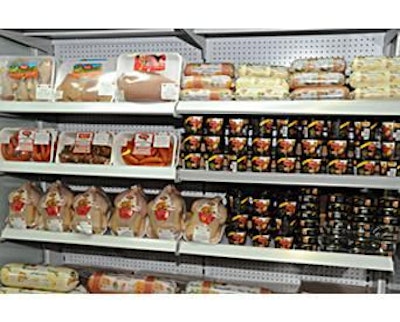
Poultry meat and egg producers around the world have had to cope with high feed prices, and the Moroccan industry is no exception. Yet, while the economic difficulties of the last few years have seen consumption of poultry meat and eggs rise in some countries, production in Morocco has been cut and consumption has fallen.
2012 saw the volume of poultry meat produced in Morocco fall for the first time in many years. Output of chicken meat declined to 440,000 metric tons from 460,000 metric tons in 2011, while that of turkey fell to 70,000 metric tons from 80,000. Per capita consumption of poultry meat in the country fell from 17.8 kg to 16.7 kg.
Despite cutbacks in production through 2012, the sale price of poultry meat was often lower than cost of production. This failure of market prices to keep pace with the production cost was first observed in late 2010, and its continuation has negatively impacted poultry meat producers, feed producers, hatcheries and slaughterhouses. The result has not simply been financial losses but also the suspension of investment.
With the start of 2013, there was some recovery in the prices, but by March and April, this upward movement had stalled. For turkey producers, signs of recovery were visible from February to May with good market prices achieved.
Chick production
2011 saw a dramatic scaling back in the placing of broiler chicks. Hatcheries agreed to cut back their breeder parent stock by 12 percent, meaning that after reaching a peak of almost 3 million head in 2010, the number of birds fell to 2.687 million in 2011, similar to the level recorded in 2009.
2012, however, saw the breeding flock start to rise again, reaching 2.848 million head across the country's 46 hatcheries. However, this momentum could not be sustained, and the total breeding flock contracted by 15 percent over the first four months of this year.
These changes inevitably fed through into the country's production of day-old chicks. The weekly quantity of chicks produced in Morocco stood at 7.3 million in January 2012 but shrank to 6.5 million by the year's end, meaning that for 2012 as a whole, production of day-old chicks stood at 350 million, which was down from 380 million in 2011.
2013 has seen some improvement with the number of produced chicks rising. FISA, the federation that brings together five of the country's poultry associations, predicts that by this August, weekly production of day-old chicks will reach more than 7.5 million.
Turkey production
As in other North African countries, the offering of poultry meat in Morocco is becoming more varied. Turkey production in Morocco started in the early 2000s, with the import of day-old turkey poults. Local poult production started in 2004. By 2008, the number produced locally surpassed the number imported and, by last year, locally produced accounted for 85 percent of the total.
Like the broiler sector, however, poult production was lower last year, falling to 11 million poults, down from 12.2 million in 2011.
Need for modernization
Although there are 23 accredited facilities for broiler slaughter in Morocco, less than 10 percent of the broilers produced in Morocco pass through regulated establishments.
The poultry industry in the country has come under tighter regulation through the adoption of Law N° 49-99 and this has resulted in significant progress in terms of health and hygiene for breeding facilities. Yet the new rules are not being applied further downstream - i.e. to those smaller operations covering slaughter and processing - and this is having consequences for the industry as a whole.
For example, although commercial catering businesses should only be sourcing meat from regulated slaughterers and processors, they are not. This is resulting in the continued survival of traditional butchers, whose hygiene standards may not be up to standard, in urban areas and town markets.
The government's failure to tackle the issue has been attributed to concerns over increasing unemployment. However, its lack of action is hampering the growth of a professional industry and the development of companies that send their birds to a professional abattoir as part of their business model. The turkey industry in particular has expressed a desire to follow a fully integrated model that includes slaughter and processing.
Eggs
Increases in feed costs have also resulted in a stabilization of Morocco's table egg production. Prices for eggs have risen, and consumer demand has weakened, further hitting large-scale producers. In 2012, the country produced 4.3 billion eggs. Per capita egg consumption of eggs, including those from small-scale operations, stood at 152.
Morocco's 233 regulated egg farms have on average 60,000 layers each. There are professional operations, with high-performance buildings and the capacity to expand production. The sector is highly organized and the country's egg producers' association, ANPO, runs regular generic marketing campaigns across television, radio and the Internet.
Better times ahead?
In an attempt to soften the impact of high feed prices, the Moroccan government has introduced a number of measures this year. Among these have been a significant reduction in the tariff applied to certain imported feed ingredients (soybean, soya and sunflower cake), a harmonization of value-added tax rates and permission to include wheat in feed.
Morocco's poultry and egg producers are expecting better times ahead. This expectation is, in part, due to the success that the sector is beginning to experience abroad. Over recent years, broiler hatcheries have started to export significant numbers of chicks and fertile eggs to other African countries. In 2012, almost 6.7 million hatching eggs were exported along with 1.9 million broiler chicks.

















